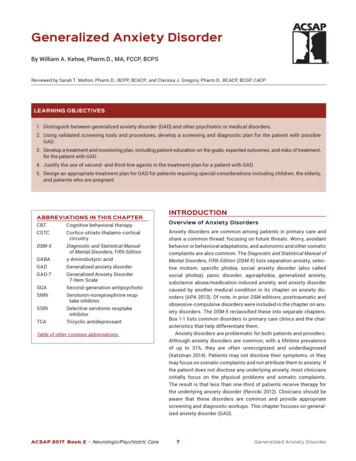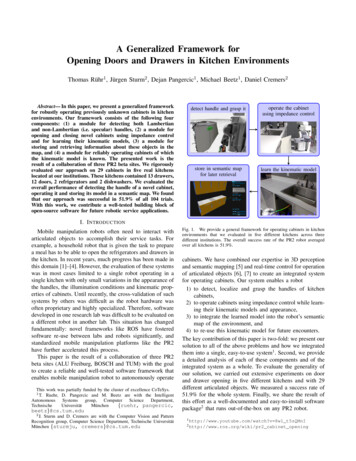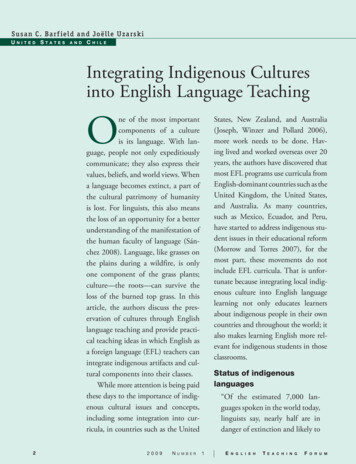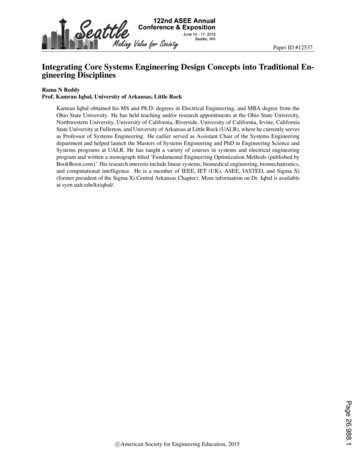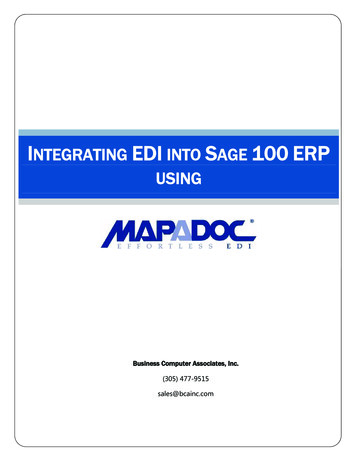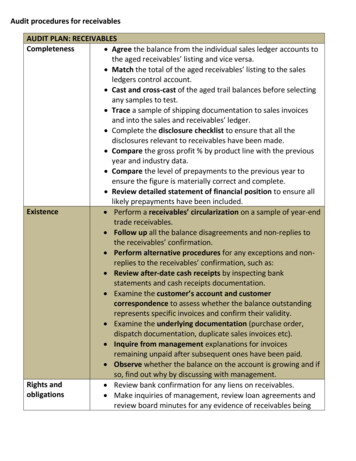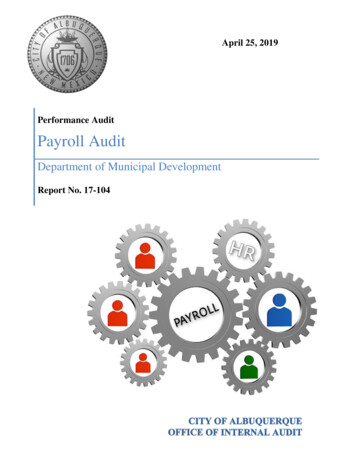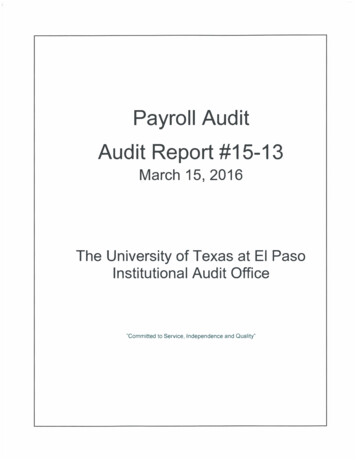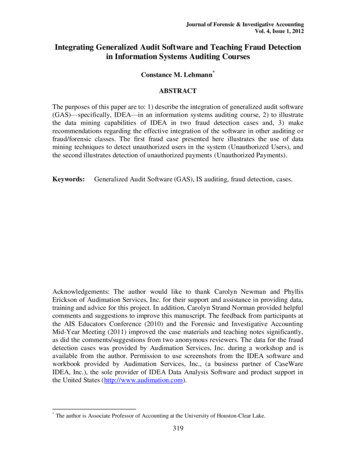
Transcription
Journal of Forensic & Investigative AccountingVol. 4, Issue 1, 2012Integrating Generalized Audit Software and Teaching Fraud Detectionin Information Systems Auditing CoursesConstance M. Lehmann*ABSTRACTThe purposes of this paper are to: 1) describe the integration of generalized audit software(GAS)—specifically, IDEA—in an information systems auditing course, 2) to illustratethe data mining capabilities of IDEA in two fraud detection cases and, 3) makerecommendations regarding the effective integration of the software in other auditing orfraud/forensic classes. The first fraud case presented here illustrates the use of datamining techniques to detect unauthorized users in the system (Unauthorized Users), andthe second illustrates detection of unauthorized payments (Unauthorized Payments).Keywords:Generalized Audit Software (GAS), IS auditing, fraud detection, cases.Acknowledgements: The author would like to thank Carolyn Newman and PhyllisErickson of Audimation Services, Inc. for their support and assistance in providing data,training and advice for this project. In addition, Carolyn Strand Norman provided helpfulcomments and suggestions to improve this manuscript. The feedback from participants atthe AIS Educators Conference (2010) and the Forensic and Investigative AccountingMid-Year Meeting (2011) improved the case materials and teaching notes significantly,as did the comments/suggestions from two anonymous reviewers. The data for the frauddetection cases was provided by Audimation Services, Inc. during a workshop and isavailable from the author. Permission to use screenshots from the IDEA software andworkbook provided by Audimation Services, Inc., (a business partner of CaseWareIDEA, Inc.), the sole provider of IDEA Data Analysis Software and product support inthe United States (http://www.audimation.com).*The author is Associate Professor of Accounting at the University of Houston-Clear Lake.319
Journal of Forensic & Investigative AccountingVol. 4, Issue 1, 2012INTRODUCTIONThe proliferation of fraud cases in the financial services (e.g., Bernie Madoff,Jerome Kervial of Societe Generale) and other industries (e.g., Enron) has resulted in thedesire to hire auditors with fraud detection and forensic skills. The importance of havingthese skills in-house for many companies as part of their internal audit function is alsobeing discussed. 1 This is in addition to calls to integrate technology into the accountingcurriculum for the last two decades. Albrecht and Sack (2000) suggested the importanceof curriculum change by integrating technology to avoid producing accounting graduatesunable to operate in our technologically advancing profession. The purposes of this paperare to a) describe the integration of generalized audit software (GAS)—specifically,IDEA—in an information systems auditing course, b) illustrate the data miningcapabilities of IDEA in two fraud detection cases developed for the course developed bythe author and, c) make recommendations as to the integration of the software in otherauditing or fraud/forensic classes. The graduate-level information systems auditingcourse described here integrates the IDEA software throughout the semester to teachfraud detection and analysis techniques, tying in the use of the software with the lectureand discussion material.Ahadiat (2008) discusses the Association to Advance Collegiate School ofBusiness International (AACSB) and AICPA requirements that students acquireexperience with technology tools in use in the profession. Their survey suggested thatwhile accounting information systems classes made some use of computer labs for classmeetings and data analysis software assignments, auditing classes did not make use of1This issue was discussed during the panel discussion (current security issues) at the October 20, 2010Information Systems Audit and Control Association (Houston Chapter) meeting.320
Journal of Forensic & Investigative AccountingVol. 4, Issue 1, 2012these. Many times, instructors are reluctant to integrate software into a class that alreadyhas more than enough topic coverage requirements to fill a semester. The addition of anew software package with its associated learning curve can be intimidating. SmithDavid, Maccracken, and Reckers (2003) point out that the high costs, along with the nonassured rewards of adding software to the course account for the reluctance of instructorsto implement technology, particularly if instructors do not feel that they are “technologysavvy.” While Smith-David et al. (2003) specifically addresses the integration oftechnology into introductory accounting courses, their comments also apply to coursessuch as auditing, fraud/forensic classes, and /or information systems auditing. This isespecially true for instructors trying to develop a new course who do not have the timeand/or resources to develop software-based assignments.Our university’s experience with Audimation Service’s Academic PartnershipProgram has provided our students with a competitive edge when they interview for jobsin the fraud examination profession. 2 This paper discusses how the IDEA software wasintegrated into a graduate-level information systems auditing (IS Auditing) class, whichuses hands-on fraud detection and analysis exercises throughout the semester. Includedhere are two fraud cases developed by the author. This paper also provides suggestions tohelp instructors integrate data extraction software into any auditing or fraud/forensicauditing class.BACKGROUNDScheiner and Kiger (1983) were some of the first to encourage the integration ofGAS into an auditing elective course. The Auditing Section Education Committee of the2CaseWare IDEA, Inc. of Canada develops the software. Audimation Services (www.audimation.com ) isthe US distributor of the IDEA software321
Journal of Forensic & Investigative AccountingVol. 4, Issue 1, 2012American Accounting Association (the Committee) (2000-2001) discussed changes in thetopic coverage in information systems auditing courses since the Groomer and Heintz(1994) study. Of the eleven syllabi for IS auditing courses reviewed, nine (81.8 percent)covered computer-assisted audit tools/techniques, as compared to 36.1 percent in theearlier Groomer and Heintz study. In addition, the Committee noted that 36.4 percent ofthe IS auditing classes were covering fraud and substantive testing of the revenue andpurchasing cycles. The IDEA software integrates especially well in these areas. Theability of the software to perform data mining and data extractions with a user-friendly,menu-driven format helps the students use hands-on techniques to apply what they arelearning in the auditing class.While Janvrin, Bierstaker, and Lowe (2008) show that the professional auditors intheir sample use audit information technology for certain procedures, such as sampling,analytical procedures, and report writing, their respondents did not indicate frequent useof audit IT for fraud review. This was in contrast to the respondents’ indication of theimportance of auditing applications for fraud review. Janvrin et al. (2008) recommendthat the audit firms expand the use of audit applications, and suggested that those settingauditing standards address the use of auditing applications in the areas of fraud review.Pearson and Singleton (2008) lament that accounting education has not kept up with theinnovations in fraud and forensic auditing. The IDEA software is an excellent datamining tool that illustrates fraud detection techniques. For example, the software cananalyze large sets of data, and can perform Benford’s analysis or other extractions todetect fraud (e.g., determining if terminated employees are still logging in to the system).322
Journal of Forensic & Investigative AccountingVol. 4, Issue 1, 2012Three years ago, a graduate-level IS auditing elective course was developedincorporating the recommended topics from the ISACA Model Curriculum for a basic ISauditing course. References used to develop class materials included the CertifiedInformation Systems Auditor (CISA) review materials, trade publications, older IT Audittextbooks, and recent articles from the ISACA Journal. The materials for the coursecurrently include a trade publication on IT Auditing and a custom book that includesauditing and forensic topics, as well as recent articles from the ISACA Journal, InternalAuditor, Fraud Magazine, and the Wall Street Journal dealing with IT and fraud auditingtopics. The recommended topic coverage in the course ties in well with the IDEAworkbook, as each chapter in the workbook covers a partial audit of a business process.Exhibit 1 is an excerpt from the course syllabus, illustrating how the IDEA software isintegrated into the course topics covered.Course Learning Objectives and Integration of the IDEA SoftwareThe learning objectives of the IS Auditing course include providing the studentwith the information to:1. Apply core concepts of IS auditing2. Recognize legislation, rules, and regulations related to IS auditing3. Analyze the unique risks of information technology and information assets4. Acquire experience conducting portions of business process audits and interpretingresults using the IDEA software. This experience includes writing formal auditreports discussing the audit findings, potential risk exposures, and recommendationsto management.323
Journal of Forensic & Investigative AccountingVol. 4, Issue 1, 20125. Learn basic techniques for fraud detection in the areas of disbursements and systemaccessThe students are introduced to the software during a lab session conducted during thethird week of class. There are five IDEA assignments in the course: three require thestudents to work through the three audit chapters in the IDEA workbook (accountsreceivable, accounts payable, and inventory), and two are fraud detection assignmentsdeveloped by the author (one addressing unauthorized users and the other addressingunauthorized payments). Each assignment is completed by the individual students andtakes them approximately 2-5 hours each.Features of the IDEA SoftwareThe IDEA educational version includes a workbook, the software CD (withrelated data files), online access to a case (with data files), and technical support for bothstudents and instructors. 3 The workbook is organized by audit. Each chapter includesstep-by-step instructions with screen shots and check figures for the audit of the area. Atthe beginning of each section is an introduction to the audit (including instructions forimporting the necessary data files), followed by a description of the potential risks of thearea, the implications of that risk, and the management assertions addressed by mitigationof that risk (see Exhibit 2). Each section of the workbook also contains an audit program,which the students are required to fill out and turn in (Exhibit 3). Students must also writean audit report discussing the audit findings, potential risk exposures, and3Instructors who enter into an academic partnership with Audimation receive a free copy of the software(limited to 5,000 records), the IDEA workbook, and the case study. The school is allowed to load thesoftware on its network as well. The workbook data files are included on the CD included with thepackage. Version 8.4 is the current version, which is compatible with Windows 7. Audimation provides theworkbook and the software to the students for about 35 (plus any bookstore markup).324
Journal of Forensic & Investigative AccountingVol. 4, Issue 1, 2012recommendations to correct the deficiencies noted. For the assignments discussed here,the students go through the workbook on their own to prepare to work the businessprocess audits. For an instructor new to integrating IDEA into their class, they can use theworkbook chapters as assignments early in the semester, and then complete the two fraudassignments included here (as is suggested in the schedule shown in Exhibit 1).The IDEA workbook illustrates the use of IDEA for many tests typicallyperformed during a fraud audit—e.g., random/stratified samples, extractions of high orlow value items, tests for duplicate checks, gap detection, Benford’s analysis, joiningdatabases with a common data field, and aging analysis.Another feature of IDEA is the history file. This file records all of the actionsperformed by the user in a particular working folder (i.e., audit) and can be printed out asan “audit trail” for the instructor to review. Items cannot be deleted from the history file,but comments can be added to help future users replicate and/or understand theprocedures performed by previous users. This file can be viewed any time the software isopen in that working folder. An excerpt from a history file is illustrated in Exhibit 4.PedagogyThe simplest way to integrate the IDEA software for fraud detection in anauditing course is to tie the chapters in the IDEA workbook to the business process auditdiscussions, as shown in Exhibit 1. The requirement that the students fill out the auditprogram and interpret their results requires them to consider the implications of theirresults on the risk assessment for the area. For example, if the results indicate that somedisbursements were made on Saturday or Sunday, this might not necessarily indicate325
Journal of Forensic & Investigative AccountingVol. 4, Issue 1, 2012fraudulent activity (e.g., if the company is open seven days a week), but should beinvestigated further, particularly if the client does not normally conduct business on theweekends. The resultant risk exposure from unauthorized disbursements could besubstantial, and recommendations of controls to limit this activity could be made once theinvestigation of noted exceptions is completed.While an instructor might choose to use the data provided with the IDEAsoftware, instructors can develop their own assignments using other data, which allowsthe students to use the workbook as a reference. 4 With the fraud detection cases discussedhere, the data mining capabilities of IDEA are illustrated, allowing an instructor tointegrate a discussion of fraud detection and forensic investigation. The two frauddetection cases developed for the graduate IS auditing course are described in the sectionentitled “Fraud Cases Using IDEA.”Benefits of Integrating IDEA into the CourseBesides addressing the issues mentioned in the Committee’s report, the benefits ofintegrating IDEA into IS auditing course include: Hands-on knowledge of a popular GAS, resulting in a more interactive approach toteaching auditing techniques and tools Practice using audit programs, performing a risk assessment, and applying auditobjectives Development of written communication skills because of the requirement to write anaudit report based on the findings4Audimation’s Academic Partnership currently works with professors using IDEA in their courses toprovide an online forum where professors can share developed cases and data files with other professorswho are members of the Academic Partnership (http://www.audimation.com/academic.cfm ).326
Journal of Forensic & Investigative AccountingVol. 4, Issue 1, 2012 Practice in the use of data mining techniques utilized in fraud detection Low cost of software and materials (free to instructors and universities, inexpensiveto students) Software compatibility with most university networks; software can also be used bythe students on their home or office computers The software is easy to learn, has excellent technical support, and discountedsupplemental training for educators is available through Audimation Services Providing the students with a competitive advantage during interviews because oftheir experience in using auditing software, performing actual fraud detectionprocedures, and analyzing their results5Limitations of the IDEA SoftwareIn our experience as a university, there have been very few problems with usingthe IDEA software over the last nine years. The software works well on institutionalnetworks, and the students have no difficulty loading IDEA on their personal computers.To become fairly conversant in the software requires a 2-4 hour investment of aninstructor’s time to learn the software (the best way to do that is to work through theworkbook). There are no licensing problems with the educational version, although aninstructor who wants to introduce the use of IDEA for large databases might find the5000 record limitation of the educational version of the software to be an issue. Thenewest versions of IDEA have added the ability to import SAP databases and are5The IDEA software is being used by many accounting firms and internal audit departments throughout theworld.327
Journal of Forensic & Investigative AccountingVol. 4, Issue 1, 2012compatible with Windows 7 operating systems. Importing text files is still somewhatchallenging, but the learning curve for this procedure not steep.GradingThese cases are used in the class as individual assignments, requiring submissionof the required materials by each student. The students receive credit for handing in thecorrect printouts and submitting their electronic files via the course support website.Exhibit 5 shows the breakdown of the scores for the various assignments. Since screenshots and check figures are provided in the IDEA workbook, the total points allocated tothe assignments from the workbook are lower than those for the fraud cases (for whichthe workbook is a reference). Exhibit 6 shows the rubrics for the “Unauthorized Users”and “Unauthorized Payments” cases (described below), allowing the instructor to assessstudent learning of basic fraud detection skills.Student FeedbackStudent feedback on the use of the IDEA software has been very positive. In theformal evaluations, the students rated the use of the software highly and wrote commentsindicating that the hands-on applications made the course more interesting and helpedthem understand the concepts they were learning. Since there is no auditing or accountinginformation systems prerequisite for the course, the knowledge levels vary among thestudents. In the three years the course has been taught at our university, there has notbeen a single negative student comment about the IDEA software. We even had a studenttaking the course who detected fraud (using IDEA) while auditing a client during his328
Journal of Forensic & Investigative AccountingVol. 4, Issue 1, 2012internship with a small accounting firm. Student comments with regard to these caseshave been very positive, as students enjoy the “investigative” nature of the assignments.The average score on the formal evaluations for the item “involving students in hands-onprojects” has averaged 4.8 (out 5). Examples of individual comments include, “lots ofprojects and hands-on cases that were interesting,” “this course really made auditinginteresting. I really liked using IDEA to do the fraud assignments.”Recommendations for Utilizing the IDEA Software in Other CoursesIntegrating the IDEA software in other classes can be accomplished quite easily.Our university has been using the IDEA software in various classes since 2002. Forexample, we have integrated this software into an undergraduate accounting elective thatteaches the students advanced spreadsheet skills and applications of IDEA in auditing.We also introduce the IDEA software in the graduate-level accounting informationsystems course to encourage students to take higher-level electives to develop their skillswith the software beyond the basics taught in the workbook. Most types of databases canbe easily imported into IDEA (e.g., DB files, Access files, Excel spreadsheets, SAP files).As an instructor becomes more comfortable using the software, he/she can develop newassignments using other data.The IDEA software can also be utilized in a fraud or forensic auditing classbecause of the data mining techniques available for detecting disbursem
Integrating Generalized Audit Software and Teaching Fraud Detection in Information Systems Auditing Courses Constance M. Lehmann* ABSTRACT The purposes of this paper are to: 1) describe the integration of generalized audit software (GAS)—specifically, IDEA—in
